
Switzerland - WAB Wengernalpbahn
For a full scale picture, please click on the picture shown !
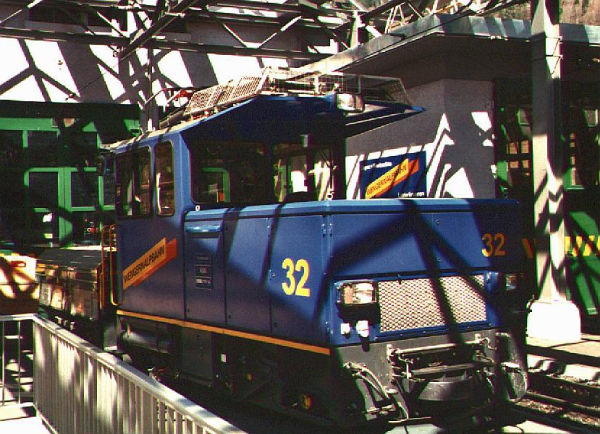
Wengernalpbahn takes people and goods from the villages of Lauterbrunnen and Grindelwald up to the carless villages of
Wengen and Kleine Scheidegg and further to the Jungfraubahn railroad from Kleine Scheidegg (2061m) up to Jungfraujoch (3475m).
Three track, cog wheel train is still today the only way to reach Wengen, a famous ski village with even Europe Cup ski events;
there is also a marked need for goods transport, which is all handled by the WAB trains. Wengernalpbahn is built with 800 mm
gauge. It is throughout built with a third rail / rack rail system according to the so called Riggenbach rail system. Maximum incline
slope is 250 promilles or 25%. There are ten stations along the line. The electric system is 1500 V DC from an overhead catenary line.
This modern freight train locomotive He 2/2 no. 32 of the Wengernalpbahn WAB is one of the two built in 1995 to replace old
and unreliable He 2/2´s from the year 1909. It weighs 16 tons. Maximum speed is a modest 22 km/h.
Photo from Lauterbrunnen, May 1999 by Ilkka Siissalo.
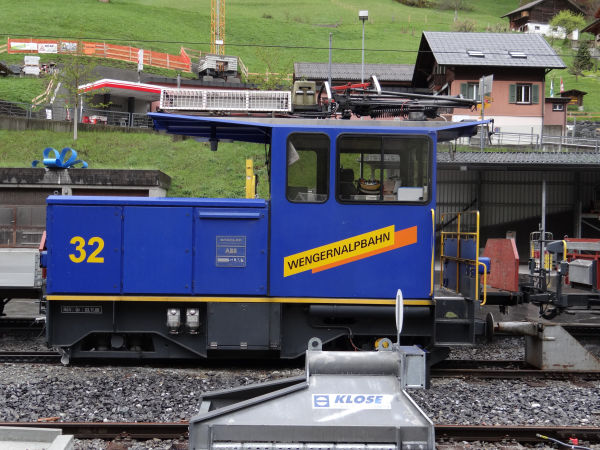
The same small cargo locomotive as shown above, but in a bit better picture.
Picture from Lauterbrunnen 1.5.2016 by Ilkka Siissalo.
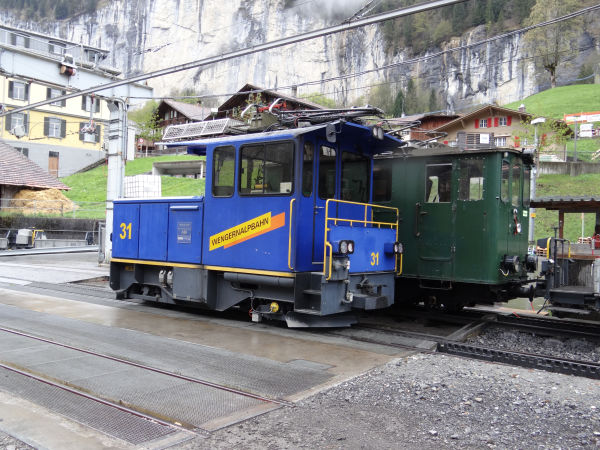
WAB's two cargo locomotives, one from 1995 and the one behind it from 1909. Both are still in active use.
Picture from Lauterbrunnen 1.5.2016 by Ilkka Siissalo.
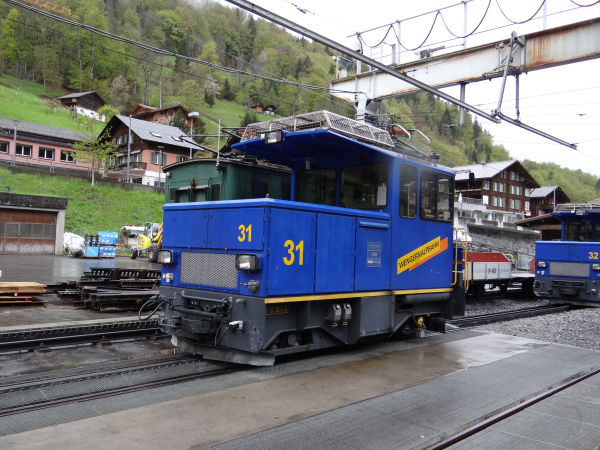
The same locomotives as shown above, but now seen from their front.
Picture from Lauterbrunnen 1.5.2016 by Ilkka Siissalo.
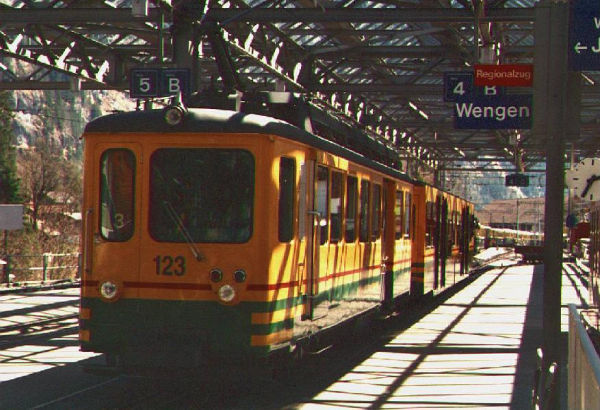
The car free village of Wengen can only be reached by the the cog wheel, rack rail
Wengernalpbahn from Lauterbrunnen. It operates like a tram, just slower. Here a WAB
BDhe 4/4 2. series no. 123 from 1970 in pair with a more modern 1998 BDhe 4/8 3.series
EMU no. 243 at Lauterbrunnen station, just about to leave to Wengen.
Photo in May 1999 by Ilkka Siissalo.
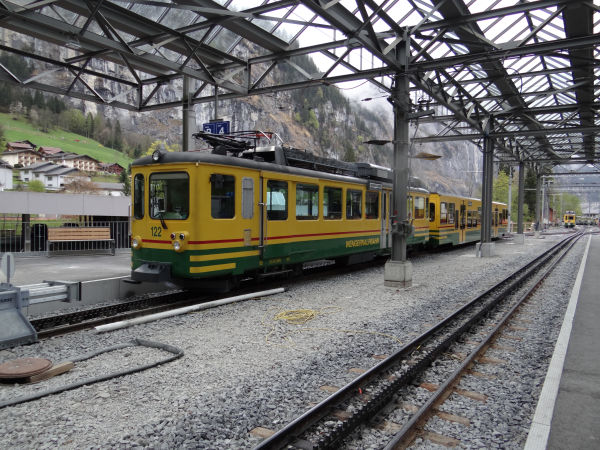
A similar composition like the one pictured above, this is the motorwagon BDhe 4/4 no.122 from 1970
together with a new low-floor motorless steering cab coach.
Photo from Lauterbrunnen station in 1.5.2016 by Ilkka Siissalo.

A closer look at the motorless new low-floor wagon no.243. It has a bending joint in the middle to help it to turn in the tight
curves of the Wengernalpbahn route.
Photo from Lauterbrunnen station in 1.5.2016 by Ilkka Siissalo.
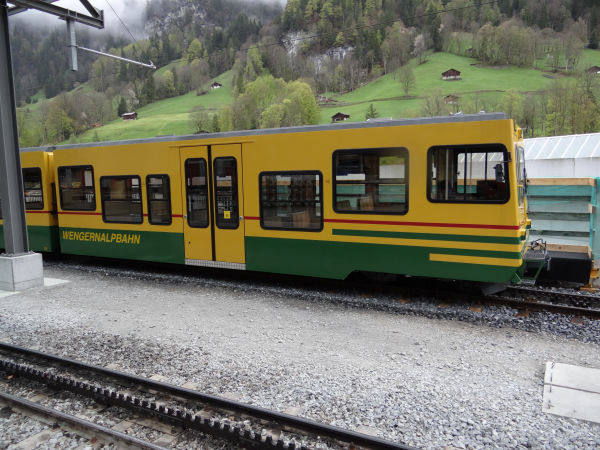
The front part of the same motorless wagon no.243 as shown above.
Photo from Lauterbrunnen station in 1.5.2016 by Ilkka Siissalo.
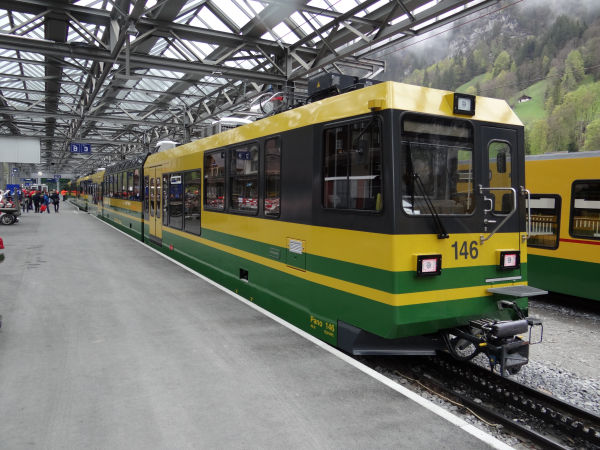
These "Pano" trains are the newest trains of WAB. It is a three coach fixed composition and two such compositions can be
coupled together, like here, to build a six coaches long train. The middle coaches of each unit have very large panorama windows
so that tourists can have a magnificent view of the surrounding mountains. The train type is officially called WAB Bhe 4/8. They were
built in two series, first in 2004 and more in 2014-15. There are now 4+6 of these new three coach multiple units. The top speed
of these trains is 28 km/h and they have 152 seats per unit. They were built by Stadler.
Photo from Lauterbrunnen station in 1.5.2016 by Ilkka Siissalo.
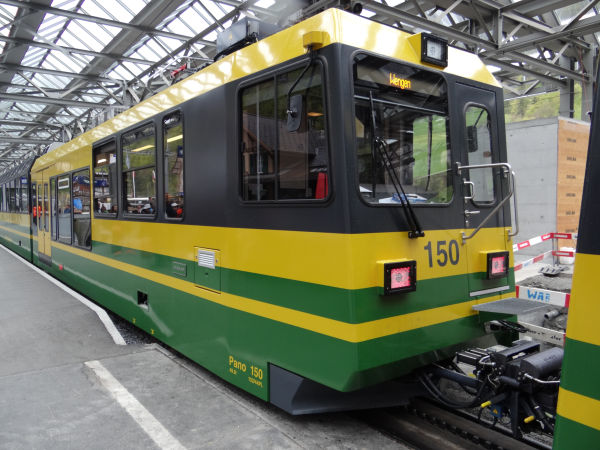
A closer look at the front of the "Pano" train no.150.
Photo from Lauterbrunnen station in 1.5.2016 by Ilkka Siissalo.
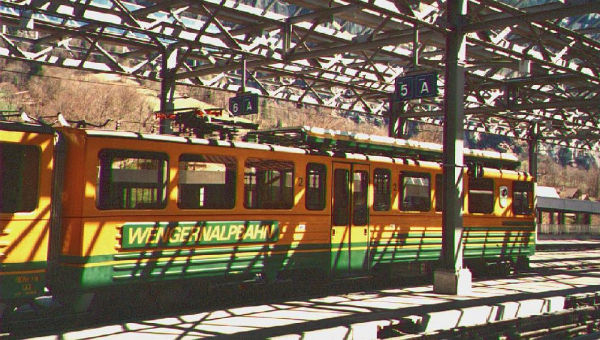
This BDhe 4/8 no 133 of WAB is built in 1988. It consists of two coaches, permanently
attached to each other. Both coaches are motorised but only the one shown here has a pantograph for
electricity. The two coaches weigh together 43 tonnes and this combination can climb the steep
slopes at a maximum of 28 km/h. There´s a large cargo compartment for skis and other goods.
Photo from Lauterbrunnen station in May 1999 by Ilkka Siissalo.
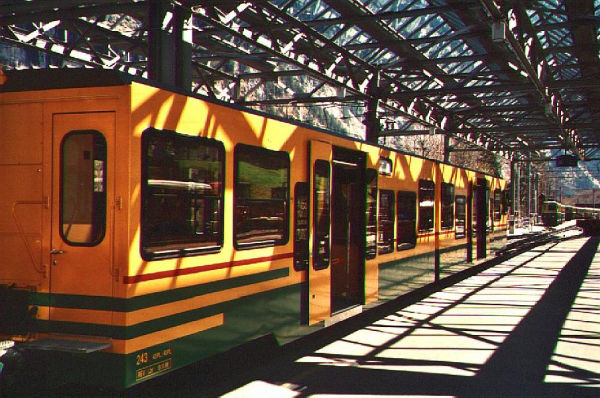
The Wengernalpbahn BDhe 4/8 2. series no 243 is like its predecessor a unit consisting of
two coaches, permanently attached. This new train was built in November 1998 and it was
the first low floor, tram-like train of WAB. Climbing on the snowy, steep hillsides
along WAB´s cog wheel three rail railroad it looks like a thing of the future in the wrong place.
Photo from Lauterbrunnen station in May 1999 by Ilkka Siissalo.

Wengernalpbahn WAB BDhe 4/4 2.series cog wheel electric motor unit no. 121
from 1970 at the Lauterbrunnen station. These EMUs were almost identical
to the 1964 built 1.series wagons, except for a bigger windscreen and a
bigger compartment for skis and luggage. Five of these EMUs operate to
the Kleine Scheidegg sking resort, 2061 m above sea level.
Photo from Lauterbrunnen station in May 1999 by Ilkka Siissalo.
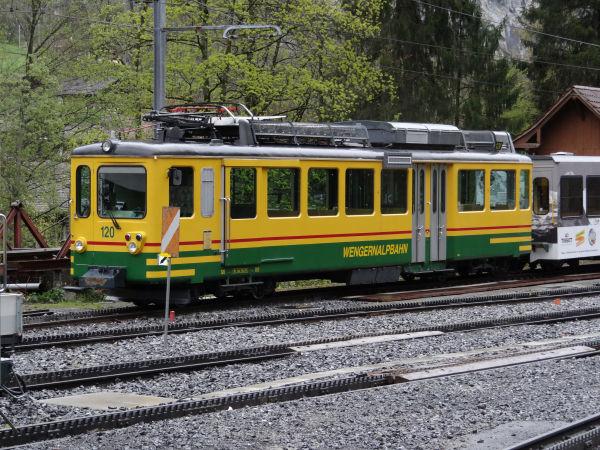
WAB BDeh 4/4 2.series no. 120
is from the same production series than the no.121 shown above, but here in 2016 this no.120 had already
been thoroughly rebuilt and modernised whereas the picture above shows the train pretty much in its original
state and livery.
Photo from Lauterbrunnen station 1.5.2016 by Ilkka Siissalo.
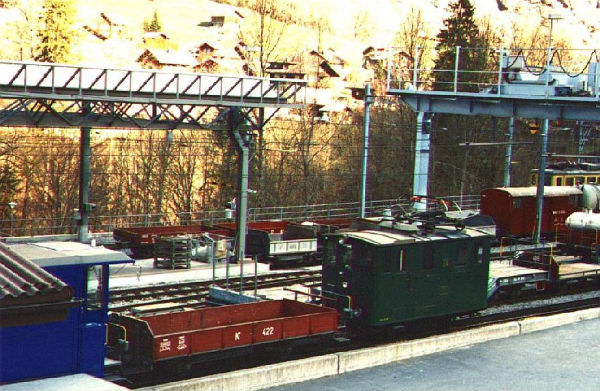
The old Wengernalpbahn WAB He 2/2 1.series locomotive no. 54 from 1909 is still in use, but
mainly only for switching wagons at the Lauterbrunnen valley station or when its two newer
siblings, He 2/2 31 and 32 from 1995 are busy. WAB bought eight of these in 1909 and a further
five in 1912. The speciality of this box-like locomotive is that its two engines are placed
very high up, which helped when they were used as electric brakes while descending the slopes.
Photo from Lauterbrunnen in May 1999 by Ilkka Siissalo.
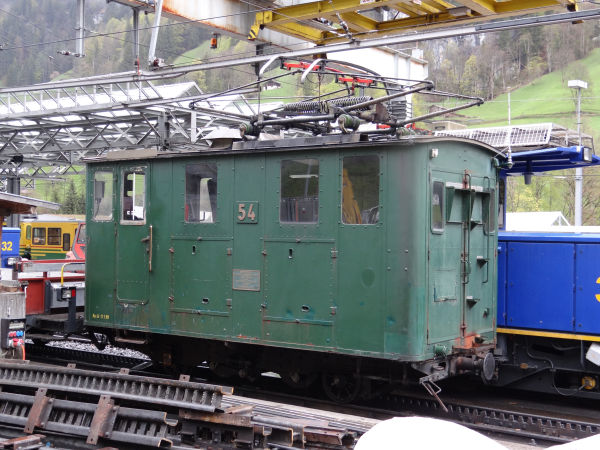
The same He 2/2 no.54 as shown above, but here seen closer by. This locomotive was built 1908 by
Schweizerische Lokomotiv- & Mashinen-Fabrik Winterthur and Elektrizitäts-Gesellschaft Alioth from Münchenstein
near Basel. For tens of years these small locomotives took care of all traffic on the WAB route.
Picture from Lauterbrunnen 1.5.2016 by Ilkka Siissalo.
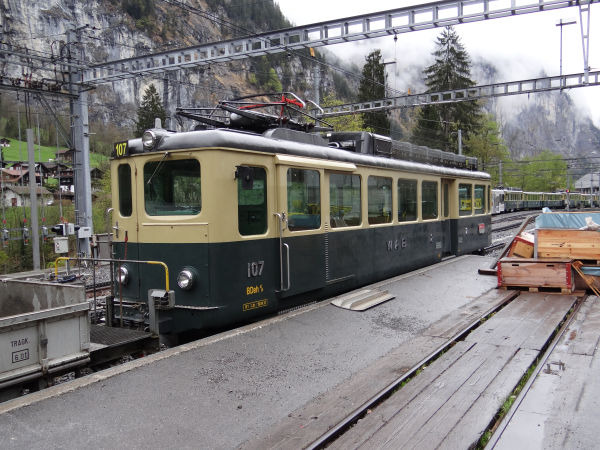
BDeh 4/4 no.107 is from the very first production series of electric multiple units of WAB. This
series was built during 1947-1958. This one is not normally used any more in passenger traffic, but it often hauls cargo loads up to Wengen and Kleine Scheidegg.
Picture from Lauterbrunnen 1.5.2016 by Ilkka Siissalo.

Wengernalpbahn WAB BDhe 4/4 2.series with a trailer wagon at Lauterbrunnen station.
Photo in May 1999 by Ilkka Siissalo.
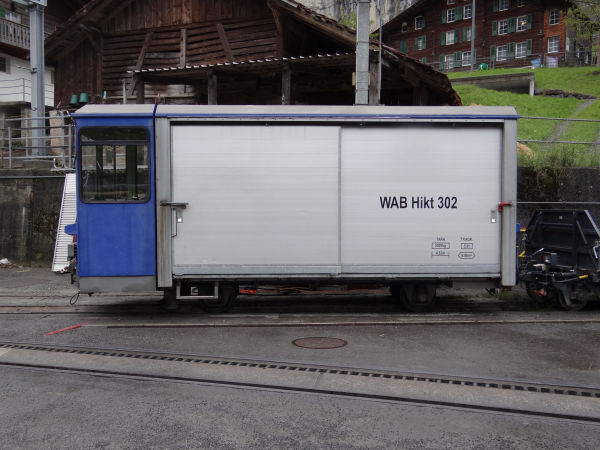
Wengernalpbahn Hikt 302 is a cog wheel drive rail truck. Since no car traffic to the village of Wengen is possible, there is a lot of need
for rail cargo equipment like this rail van.
Photo from Lauterbrunnen 1.5.2016 by Ilkka Siissalo.
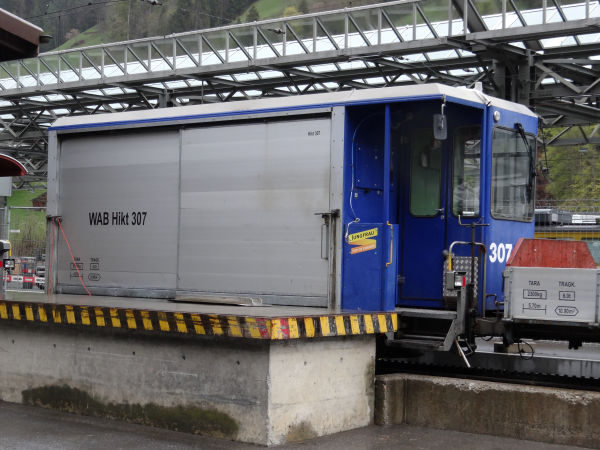
Wengernalpbahn Hikt 307 is a similar rail van like the Hikt 302 shown above. Here it is seen from the other side.
Photo from Lauterbrunnen 1.5.2016 by Ilkka Siissalo.
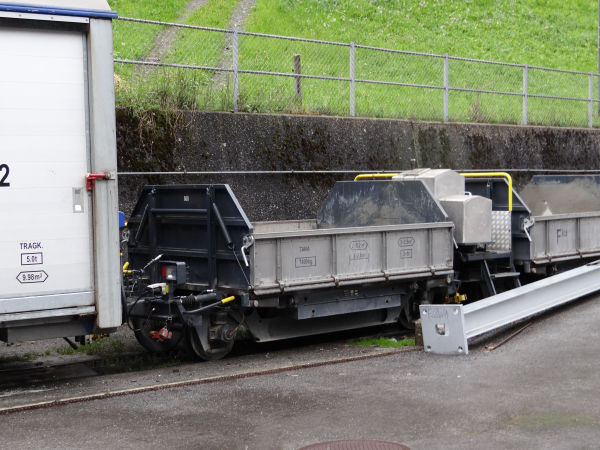
Special wagons for transportation and spreading of ballast and gravel.
Photo from Lauterbrunnen 1.5.2016 by Ilkka Siissalo.

One of the Wengernalpbahn WAB He 2/2 locomotives, no. 55 from 1910 is kept as a museum piece
on the yard of the Elektra Birseck, the electricity company of Kanton Baselland. It operated
until 1969 at the Lauterbrunnen-Kleine Scheidegg-Grindelwald route, 1969-93 as no.15 at the
Schynige Plattebahn railroad, 1993-97 as a switcher engine at the WAB Lauterbrunnen station,
like its sibling no. 54 still does.
Photo from Birseck May 1999 by Ilkka Siissalo.
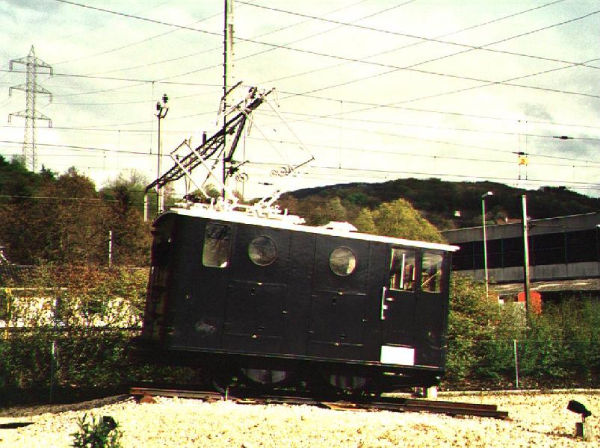
The WAB He 2/2 no 55 museum engine shown sideways. It was built mechanically at SLM,
Winterthur, in 1910 with all electrical parts from Elektrizitätsgesellschaft Alioth,
Münchenstein - a predecessor of the company whose yard it now stands on. It´s 5,75 m
long, weighs 16 tons, had a maximum speed of 12 km/h on cog wheel track and used
1500 V DC current, which is still used by WAB.
Photo from Birseck May 1999 by Ilkka Siissalo.

